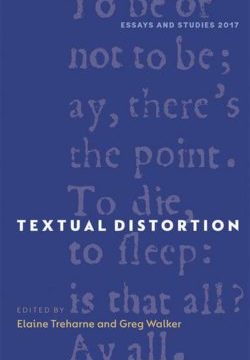Treharne, Elaine and Greg Walker, eds. Textual Distortion. The English Association: Essays and Studies. Cambridge: D.S. Brewer, 2017. 188 p. ill. ISBN 9781843844792. US $39.95 (hardcover).
In the introduction to Textual Distortion, a volume of essays published as part of the English Association’s “Essays and Studies” series, Elaine Treharne notes that the process of distortion “remains resolutely associated with the undesirable, the lost or the deceptive” (1). In response to this primarily negative view of distortion, the nine essays that Treharne and her co-editor, Greg Walker, have assembled in this collection document the “varied, dynamic and often positive role of distortion in the transmission and reception of texts” (5). Many of the essays approach distortion from a bibliographic or book-historical perspective, examining the distorting effects of various processes of textual transmission, such as scribal intervention, photo-facsimile reproduction, and digital manipulation. Other essays treat distortion as a mediating factor in the transmission of historical and literary discourse. Taken together, the essays do not share a single thesis or build towards a common definition of distortion, but this multiplicity of approaches is intentional. Treharne claims that, through the variety of essays in the collection, the process of distortion “is demonstrated to demand a rich and provocative mode of analysis” (2).
The first essay in the collection sets the tone for many of the essays that follow by providing a nuanced account of the interplay between textual materiality and distortion. Matthew Aieollo examines two non-deluxe eleventh-century codices (Bodleian Library, Junius 85 and 86) that scholars generally believe “once constituted a single manuscript that was split into separate volumes at a later date” (7). Aiello deploys careful codicological and paleographic analysis in order to suggest that the two volumes were, in fact, split at the time of their composition by one of the manuscript’s scribes. Aiello uses this detailed case study to make a broader argument about “the importance of fully investigating books that are humble in design, and plain in production” (24).
Building on this materialist approach, four of the collection’s essays go on to examine the types of distortions that are often the result of transferring a text from one medium into another. Emma Cayley explores the afterlives of two medieval manuscripts, the Exeter Book of Old English Poetry and the Songe de la Pucelle, by examining their reappearances in print, in digital apps, and, amusingly, in hotel carpets. She argues that “modern forms of the book can and will multiply and enhance reading experiences in ways that medieval authors in particular would surely have approved of” (31). Giovanni Scorcioni, a bookseller who specializes in the creation of high-quality reproductions of manuscript texts, provides a detailed overview of the processes required to create facsimiles; his essay will be especially enriching for scholars who deal regularly with facsimile reproductions. Greg Walker examines a series of medieval Lollard manuscripts that were revived in print during the Reformation Parliament of 1529, arguing that “these revenant texts distorted not simply the certainties of their own moment in time, but the early-modern sense of time and history more generally” (149). In the collection’s final essay, Claude Willan studies a print error in a single copy of an eighteenth-century tract, An Answer to the Arguments in the Lord Bishop of Oxford’s Speech, and proceeds to examine how digital text-recognition software has read (or failed to read) these material distortions in the original book-object.
The collection’s other four essays examine how literary and cultural institutions distort the process of textual transmission. Aaron Kelly’s essay on the work of the 1930s British author Lionel Britton begins with an overview of the relationship between ideology and distortion in Marxist theory before turning to Britton himself; in Kelly’s reading, Britton’s formally experimental plays and novels distort the notions of chronology and of individual agency exemplified by bourgeois literary forms. In her essay entitled “Dictionary Distortions,” Sarah Ogilvie, a professional lexicographer, challenges the oft-held assumption that dictionaries are authoritative and that they can, therefore, distort everyday language. In the second part of her essay, she goes on to argue that the Oxford English Dictionary’s founding nineteenth-century editors “were not as Anglocentric as scholars and readers thought” (93), showing that the generally accepted history of the dictionary is, itself, distorted.
Timothy Powell’s essay about the use of drums in Ojibwe storytelling offers a compelling critique of the limitations of the early-American literary canon; by highlighting the importance of embodied practice in Ojibwe culture, he suggests that academic emphasis on print culture has distorted our understanding of indigenous forms of art and their place in literary history. In another essay that, similarly, examines the distorting qualities of overly-prescribed academic discourse, Daeyong (Dan) Kim challenges the notion that post-independence Korean productions of Shakespeare are best understood through a national framework. He suggests, for instance, that Oh Tae-Suk’s 2011 production of The Tempest demands an interpretative lens that accounts for the “hybrid contexts now emerging or not yet imagined” (84). A strictly nationalist reading of Shakespeare, Kim contends, distorts the multi-national resonances of his plays.
By pointing to the need for less rigid or prescribed discursive frameworks, both Kim and Powell make a point that, in many ways, helps to explain the shape of the volume as a whole. The gathering of essays seems, at times, inharmonious, but by bringing together a variety of scholars from such a broad range of fields, Treharne and Walker have tried to “deliberately challenge periodization and the canonical” (2). Textual Distortions is a collection of essays about distortion, but it is also one that cleverly distorts rigid disciplinary, temporal, and methodological boundaries.
Mathieu Bouchard, McGill University


